Sentinel Online
29 September 2016
Information on the Sentinel program, including mission status reports and access to SLSTR data can be found via Sentinal Online.
ATSR-2 post July 2003 products now available
29 January 2016
The data from real-time downloads to ground stations that took place following the failure of ATSR-2's onboard tape recorders have now been processed and are available to download from the ATSR multimission archive at CEDA in Harwell, UK. The following two images are examples from 1 August 2007. The image on the left shows land surface temperature and image on the right shows sea surface temperature.
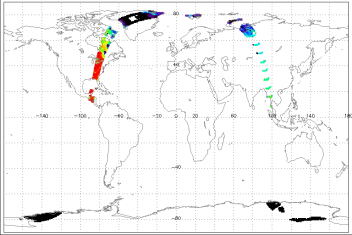
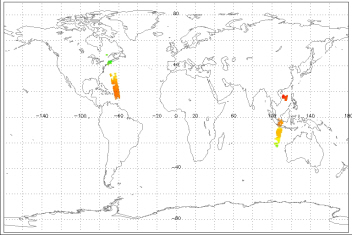
SLSTR Undergoes Calibration at RAL
14 March 2015
SLSTR was delivered to the Rutherford Appleton Laboratory (RAL) in January 2015 and is now undergoing the pre-flight calibration testing that is essential for providing accurate and traceable measurements. SLSTR is due for launch in October 2015 on the Sentinel 3 satellite.

AATSR Principal Investigator retires
16 May 2014
Dozens of friends and colleagues gathered at College Court in Leicester today to celebrate the achievements of Professor David Llewellyn-Jones, AATSR Principal Investigator and co-originator of the ATSR series. Colleagues from Leicester, RAL, DECC and ESA gave warm tributes to David's scientific leadership not only of the ATSR series but to many other projects at RAL and in the Earth Observation Science group at Leicester, which he established 20 years ago. The celebration included a short symposium on ATSR (below left) followed by a retirement dinner at which David received, amongst other gifts, an original ATSR T-shirt (below right). David is now moving to Swansea with his wife Peggy for a well-earned retirement. However, we would not be surprised to see him again at future meetings on ATSR!
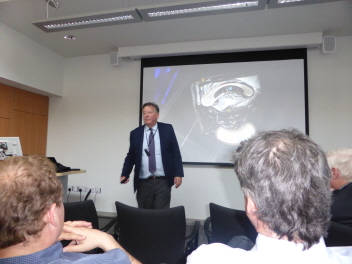
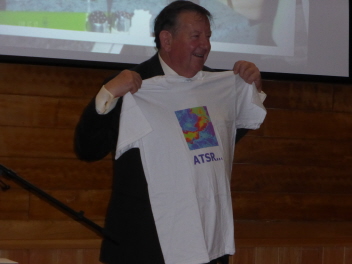
ATSR v2.1 archive now available
30 September 2013
The third major reprocessing of the ATSR data series has now been completed, leading to the creation of the ATSR v2.1 archive hosted by the ATSR mirror sites at the NEODC in Harwell, UK and the UK-MM-PAF in Farnborough, UK.
The improvements over the ATSR v2.0 archive include:
- improved SST retrievals using updated SST coefficients supplied by the (A)ATSR Reprocessing
for Climate (ARC) project.
- consistent calibration is implemented for the reflectance channels.
- improved cloud identification.
- improved collocation between the nadir and forward views.
- improved absolute geolocation accuracy in the nadir view.
An updated version of the L2P dataset is available, generated by a new processor based upon the ARC processor and now in NetCDF-4 format and compliant with GDS V2. The L3U product is an entirely new product for ATSR and consists of the ARC L2P dataset remapped onto a regular lat/lon grid, also in NetCDF-4 format.
The 4th reprocessing is under preparation with the main purpose to align the ATSR series dataset with Sentinel-3 SLSTR data.
ATSR at The Living Planet Symposium
13 September 2013
ATSR has been well represented in papers presented at ESA's Living Planet Symposium in Edinburgh. During the symposium, the UK Space Agency hosted the following Prezi presentation on their stand:
Improvements to the ATSR data series are underway
15 January 2013
The AATSR Quality Working Group (QWG), meeting at ESRIN on 15 - 16 January 2013, agreed the final details of the third major reprocessing of the ATSR data series. This will include geolocation corrections, improvements to the collocation of the forward and nadir views, improved visible calibration and several other improvements to each instrument dataset. The reprocessing will start next week and the full reprocessed data series (Version 2.1) will be available by June 2013.
Looking forward to SLSTR
19 October 2012
The AATSR Principal Investigator, Professor David Llewellyn-Jones, delivered an opening address on The lessons learned from AATSR and Bridging the Gap to SLSTR at the Sentinel-3 OLCI/SLSTR and MERIS/(A)ATSR Workshop, which took place at ESRIN on 15 - 19 October 2012. Professor Llewellyn-Jones emphasised the importance of continuing in situ measurements that are traceable to SI reference standards, noting that a crucial element of this is ship-borne radiometry. The workshop included many presentations on AATSR and SLSTR topics, which are summarised in the workshop session summaries.
AATSR performance and mission highlights are reviewed
11 October 2012
Drs. Dave Smith (RAL) and Philippe Goryl (ESA) presented respectively, the AATSR Instrument Performance and the AATSR Mission Highlights at the Envisat Instrument Operations Performance (IOP) Closeout Meeting, which took place at ESRIN on 11 - 12 October 2012. All the instrument teams were represented at the meeting and their presentations can be obtained from ESA. The ENVISAT AATSR Instrument Performance - End of Mission Report provides the definitive summary of AATSR performance.
AATSR loss impacts accuracy of OSTIA
31 May 2012
The loss of AATSR skin SST measurements has impacted the quality of the Met Office's Operational Sea Surface Temperature and Ice Analysis (OSTIA). Since the OSTIA system lost the operational AATSR data as a reference to bias correct the other satellite data, in situ data alone have had to serve as a reference. To quantify the impact, two runs of OSTIA were made for March 2012, one with the AATSR data and the other without. The accuracy of the OSTIA SST product from these runs was validated against independent near-surface Argo data. It was found that the Argo observation-minus-analysis standard deviation errors (SDE) of the OSTIA SST increase globally from 0.47 K to 0.53 K when AATSR data are not included in the analysis. A variable increase in the SDE is seen across all ocean regions, with the largest increase occurring in the Indian Ocean where the SDE increases from 0.28 K to 0.41 K. For tables and figures, please see GHRSST Newsletter No. 7.
Envisat mission ends but AATSR mission continues
18 May 2012
ESA has announced that the Envisat satellite mission has come to an end following the irreparable failure of the communications link with the satellite on 8 April 2012. This marks the end of a very successful 10 year mission, double the original design life, that has seen the maturation of several environmental measurements, including SST from AATSR. Although there can be no further measurements from Envisat, the AATSR mission on the ground will continue for some time as further data quality improvements are implemented as part of a planned reprocessing of the archive. The ongoing aim of the ATSR science team is to provide the best consolidated ATSR-series datasets for long-term environmental monitoring.
ATSR Special Issue of 'Remote Sensing of Environment'
31 August 2011
The ATSR science team has generated a Special Issue of Remote Sensing of Environment (RSE). The 18 papers in the issue range across all the applications of ATSR, including SST, LST, fires and aerosols. Subscribers to RSE can download the articles in press from the RSE website. The paper issue will be published very early in 2012.
AATSR Flight Spare donated to the Science Museum in London
4 December 2010
DECC has donated the AATSR Flight Spare structure (below left) to the Science Museum in London, for a special exhibition entitled 'Atmosphere: exploring climate science'. The exhibition opened to the public on 4 December 2010. The exhibit includes a video by the AATSR Principal Investigator, Professor David Llewellyn-Jones, outlining the main features of the AATSR instrument (below right). The Flight Spare had previously been housed at the National Space Centre and the foyer of the Physics Department at the University of Leicester.
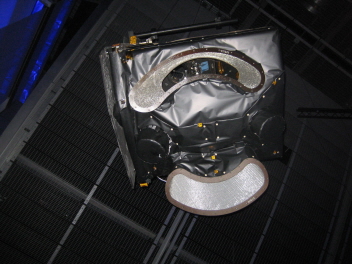
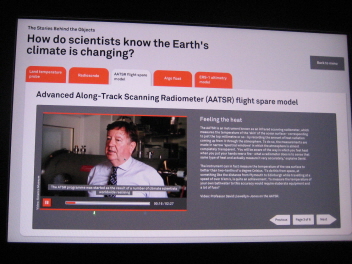 ATSR multi-mission archive now available
ATSR multi-mission archive now available
8 June 2010
ESA has announced the completion of the ATSR multimission archive, now including the full set of GHRSST L2P products.
RAL hosts ATSR celebration
22 October 2009
RAL generously sponsored a celebration to mark the completion of the first long-term, consistently processed ATSR archive. The event included a dinner, which was addressed by Professors Bob Watson, John Harries, Chris Rapley and David Llewellyn-Jones, with Sir John Houghton, one of the chief instigators of the ATSR series, giving the keynote speech. Many of the individuals who played key roles in the development of the ATSR instruments and ground segment were present at the dinner and at an earlier symposium, which included the following presentations on ATSR and its applications:
- Welcome to RAL (Richard Holdaway)
- Why is ATSR so good? (David Llewellyn-Jones)
- ATSR Technology (Mike Sandford)
- Pre-launch characterisation (Graeme Mason)
- ATSR onboard blackbodies (Ian Mason)
- ATSR performance (Dave Smith)
- SST time series (John Remedios)
- ATSR and climate (Roger Saunders)
- ATSR and weather (Craig Donlon)
- ATSR applications (Olivier Arino)
- What comes next? (Chris Mutlow)
- Closing remarks (Ian Robinson)
There is also a summary of the event available.
The inaugural meeting of the ATSR Exploitation Board was held on the same day.
|

